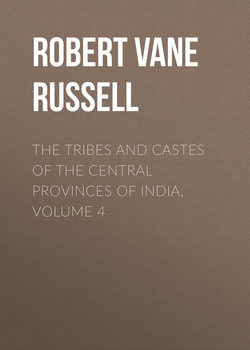Читать книгу The Tribes and Castes of the Central Provinces of India, Volume 4 - Robert Vane Russell - Страница 91
Part II
Articles on Castes and Tribes
Kumhār—Yemkala
Vol. IV
Lakhera
5. Red, a lucky colour
ОглавлениеIt may be noted, however, that lac bangles are not always worn by the bride at a wedding, the custom being unknown in some localities. Moreover, it appears that glass was known to the Hindus at a period prior to the Muhammadan invasions, though bangles may not have been made from it. Another reason for the use of lac bangles on the occasions noticed is that lac, as already seen, represents blood. Though blood itself is now repugnant to the Hindus, yet red is pre-eminently their lucky colour, being worn at weddings and generally preferred. It is suggested in the Bombay Gazetteer85 that blood was lucky as having been the first food of primitive man, who learnt to suck the blood of animals before he ate their flesh. But it does not seem necessary to go back quite so far as this. The earliest form of sacrifice, as shown by Professor Robertson Smith,86 was that in which the community of kinsmen ate together the flesh of their divine or totem animal god and drank its blood. When the god became separated from the animal and was represented by a stone at the place of worship and the people had ceased to eat raw flesh and drink blood, the blood was poured out over the stone as an offering to the god. This practice still obtains among the lower castes of Hindus and the primitive tribes, the blood of animals offered to Devi and other village deities being allowed to drop on to the stones representing them. But the higher castes of Hindus have abandoned animal sacrifices, and hence cannot make the blood-offering. In place of it they smear the stone with vermilion, which seems obviously a substitute for blood, since it is used to colour the stones representing the deities in exactly the same manner. Even vermilion, however, is not offered to the highest deities of Neo-Hinduism, Siva or Mahādeo and Vishnu, to whom animal sacrifices would be abhorrent. It is offered to Hanumān, whose image is covered with it, and to Devi and Bhairon and to the many local and village deities. In past times animal sacrifices were offered to Bhairon, as they still are to Devi, and though it is not known that they were made to Hanumān, this is highly probable, as he is the god of strength and a mighty warrior. The Mānbhao mendicants, who abhor all forms of bloodshed like the Jains, never pass one of these stones painted with vermilion if they can avoid doing so, and if they are aware that there is one on their road will make a circuit so as not to see it.87 There seems, therefore, every reason to suppose that vermilion is a substitute for blood in offerings and hence probably on other occasions. As the places of the gods were thus always coloured red with blood, red would come to be the divine and therefore the propitious colour among the Hindus and other races.
85
Hindus of Gujarat, App., art. Vaghri, footnote.
86
Religion of the Semites.
87
Mackintosh, Report on the Mānbhaos..
